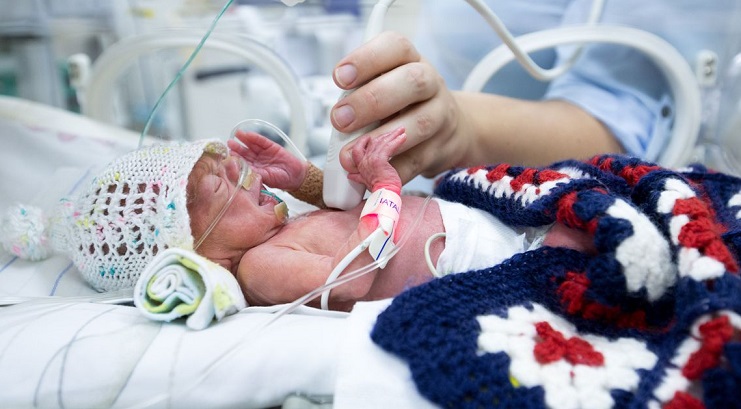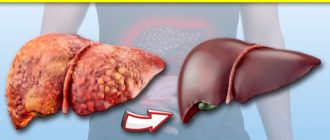In this article you will find information about what the features of premature children are. You will also learn how to feed and care for such a baby correctly.
Contents
- Signs of terminations and prematureness of newborns: Description
- Features of premature children up to a year
- Why does a newborn premature child need special care?
- Anatomical and physiological, functional, morphofunctional features of eight-month premature children: risks
- Premature children: temperature regime
- Premature children: bathing, walking in winter and in the warm season
- Premature children: food, feeding
- General regime of the day, recommendations and development of premature children
- Racititis in a premature child: causes, signs, diagnosis, treatment
- Video: Honest answers to questions about premature children
Premature children ceased to be rare, in maternity hospitals, babies with weight deficiency are increasingly being born. Basically, these are newborns with a body weight of not more than 2500 kilograms and a length of 45 centimeters. The answer to the question of why a woman gave birth to a earlier period should be sought in the period of pregnancy, most often it is the lifestyle of the future mother who becomes the main reason for the child’s prematureism.
Often, during pregnancy, hidden chronic diseases begin to develop that it is advisable to track at an early stage of pregnancy, it is they who can cause a child’s prematureism. Also, if a woman is smoking during pregnancy, consume strong drinks, then with a more probability her child will be born ahead of schedule and with her bouquet of diseases.
Signs of terminations and prematureness of newborns: Description
In premature babies born before the expected duration of childbirth, the formation of some organs and systems has not yet been completed, which is manifested by certain deviations on their part.
As mentioned above, a child born before the deadline is up to 37 weeks of pregnancy, with a weight of up to 2500 grams, is premature.
It is worth knowing: All premature babies born after 22 weeks of pregnancy are nursed, with body weight from 500 g.
A premature baby will visually have a disproportionate body, and a number of signs indicating the immaturity of the body.
Here is a description of the signs of foundation and prematureness of newborns:
- The seams of the skull - a large and small fontanel will be open.
- The cry is weak. A full -term baby screams loudly.
- The child will have wrinkled skin, dry to the touch and reddish. This skin color is due to the fact that the skin of the crumbs is still very thin, translucent, and the subcutaneous-fat layer is not yet “winning” to a sufficient extent.
- Flush hair on the skin of the face, hands, body - lanugo. In a full -term child, it is normal in Lanugo, or weakly expressed.
- The nails on the fingers are thin, have not yet grown up to the end and do not reach the end of the phalanges.
- The ears are not straightened to the end, they are soft, fit close to the head.
- From the genitals - in girls it will be seen that the large labia does not close the small ones, in the boys the testicles did not fall to the end into the scrotum.
- The kid is still weak for the life of the mother, it is difficult for him to suck and swallow milk. A full -term baby immediately enough breasts, as soon as he is brought to his mother.
Features of premature children up to a year
It is worth noting such features of premature children, which are especially manifested in the first month of life after birth:
- Jaundice characteristic of many newborn babies, which occurs almost immediately after birth, in premature children appears a little later than in ordinary children. Such a jaundice passes longer and drags on to a month.
- The umbilical wound heals longer. Nature did not provide that the child would be born ahead of schedule, it was assumed that the umbilical cord is still necessary for the baby, for life in the womb. Therefore, the umbilical residue will be more thick, “powerful”, juicy.
- The thermoregulation of the premature has not yet stabilized completely, as a result of which a child can easily be overheated and hypothermia. We will have to very carefully observe a certain temperature regime so as not to harm the baby. That is why, premature children are placed in kuves - specially equipped devices, in the form of a transparent box, inside which the optimum temperature is maintained.
- In some prematurely within 1-2 weeks after the birth, swelling may appear, mainly on the stomach and lower extremities.
- In infants, lethargy and constant drowsiness may be observed.
During the first year of life, the growth of body weight in a premature child occurs faster than in the full -term. This is due to the fact that it is born with a lack of weight. According to anthropometric indicators, a premature child will catch up with his peers of full-term children-by 2-3 years. There were cases that this happened by 5-6 years.
It's important to know: The lag in psychomotor and speech development depends on the degree of prematurity and available pathologies. If the script is favorable, then the leveling will occur in the second year of life.
Why does a newborn premature child need special care?
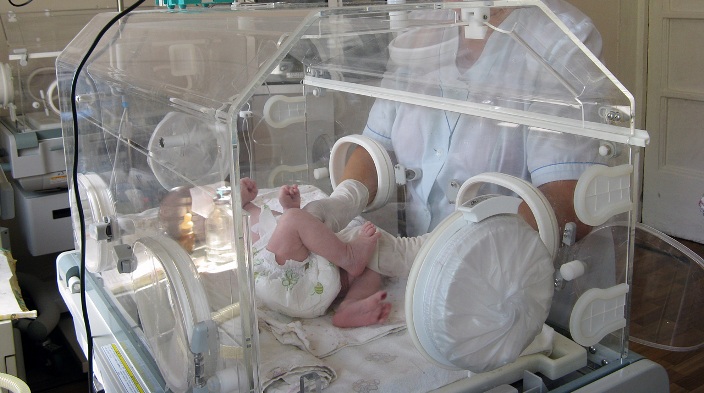
Today in maternity hospitals, the resuscitation system is well developed. With a probability of 90%, the child will leave the hospital in a healthy state. If the newborn requires constant control by medical personnel, the child and mother from the hospital are immediately transported to the hospital. It is in the medical institution that the baby is “put on the feet”, only after that the mother and the child are prescribed. Why does a newborn premature child need special care?
It's important to know: Premature children are more susceptible to any infectious diseases than the kids who were born exactly on time, it is why doctors advise protecting the newborn from any contacts with sick people.
Rarely anyone thinks why everything is very sterile in the maternity hospitals, and quartz lamps are used. The reason for all this is dust. Polvo disputes often become carriers of Staphylococcus. Wet cleaning in the Gener should become a constant “habit”, it is also worth acquiring a moisturizer with a sink function or quartz lamps, a young mother should protect her premature child from any possible infectious threats.
Remember: At home, after discharge from the hospital, control over the state of the newborn is completely placed on the shoulders of parents or other relatives.
Anatomical and physiological, functional, morphofunctional features of eight-month premature children: risks
It is worth noting that the prematurity of the newborn is determined not only by anthropometric, but also by anatomical, physiological, functional and morphofunctional indicators. After all, it is important not only with which indicators the baby was born, but also how he can live and develop later. Particular attention is paid to anatomical, functional, morphofunctional indicators of eight-month premature babies, since such children may not survive. Here are the features and possible risks:
- Superficial, frequent and weakened breathing, a tendency to apnea. Due to the poor development of tissues, it is easy, premature babies can have pulmonary diseases: pneumonia, respiratory distress syndrome.
- An insufficiently matured cardiovascular system leads to the lability of the pulse, tachycardia, muffled heart tones, hypotension.
- The morphological signs of immunity of the central nervous system include weakened differentiation of gray and white matter. The grooves of the brain are smoothed, the myelinization of the nerve roots is incomplete.
- The muscles are weak, because of which weak physiological reflexes. The reaction to stimuli is slowed, thermoregulation is impaired (body temperature can be either increased or low - depends on external factors).
- Functional immaturity of the gastrointestinal tract. Premature children are predisposed to frequent regurgitation, flatulence, dysbiosis. The jaundice in such babies is more pronounced and proceeds longer.
- The immaturity of the kidneys leads to a change in the electrolyte balance. Swelling, rapid dehydration, decompensated metabolic acidosis may appear.
- The endocrine system also works with interruptions and there is a delay in the formation of circadian rhythm of hormone secretion. The glands are quickly exhausted. Physiological mastitis and vulvovaginite in girls may develop.
In the subsequent life of women who were born prematurely, can suffer from violations of the menstrual cycle. They can have sexual infantilism and is noted in almost every case of spontaneous termination of pregnancy and premature birth.
Premature children: temperature regime

Caring for a premature child is difficult. It is necessary to feed it correctly and observe the daily routine. It is also important to observe the temperature regime. The health of the baby, its development and how quickly it will get stronger depends on it. Read more about the care of the house.
Temperature mode:
- Any newborn does not “control” the temperature of his body, but things are worse in premature children, they have completely absent thermoregulation.
- If the child was born much earlier than the set time, doctors put him in a “capsule”, where not only the ambient temperature is clearly regulated, but also air humidity. In such "incubators" its microclimate is created.
- Often, by the time of the newborn discharge, the temperature regime of the body is normalized, and ceases to be a threat to the health of the child.
- Pediatricians and other children's doctors strongly advise maintaining the temperature in the children's room in the region of 20-22 degrees, also in the cold season, the living room should be ventilated at least three times a day, in the warm period, experts consider it useful to constantly keep the window ajar, but not allowed to allow drafts.
Important: With through ventilation of the newborn, it should be carried away from the room!
Advice: Do not sharply try to accustom the child to change the temperature. Such manipulations should take place smoothly and without stress for a small organism.
Premature children: bathing, walking in winter and in the warm season
It's believed that the newborn needs to bathe Every day for six months:
- It is much easier to accustom the child to water procedures if they pass at the same time planned time or evening.
- The first bathing should take place at a water temperature of 37 degrees, over time reducing it, by the end of the first half of the year the thermometer should show 35 degrees of water.
- Such manipulations will help to quietly temper a young body.
Do not forget about daily walks in the fresh air. After the first month, when the baby has grown and strongly, you can start walking:
- Doctors strongly advise starting to walk with the child only a month after discharge.
- In the warm season, it is advisable to do this in places with a large accumulation of trees, because they perfectly produce pure oxygen.
- Do not roll a stroller near busy tracks and other places of closing cars.
- The first walks should not last more than half an hour. Every day you need to add 5 minutes. In the warm, calm season, when the temperature is above zero, walks can be started from the first days of the child’s life, without waiting for the end of the first month.
- Over time, you can increase the duration of the newborn on the street to 2 hours, if the street is warm and there is no strong wind.
In winter, in the cold months It is allowed to walk with the newborn at a temperature of up to -10 degrees. If the weather is very windy and the air temperature is below the permissible indicators, it is not recommended to go out on the street so as not to get a small body.
Premature children: food, feeding
Flottering, food:
- For any newborn, and especially a premature child, the most delicious, as well as healthy nutrition is breast milk.
- It has all the substances that are necessary for a small, fragile organism.
- Today, more and more often you can find a problem with lactation in young mothers, it happens that there is no milk at all.
- In such a critical situation, the baby must be transferred either to mixed feeding (breast milk + milk mixture), or completely for artificial nutrition.
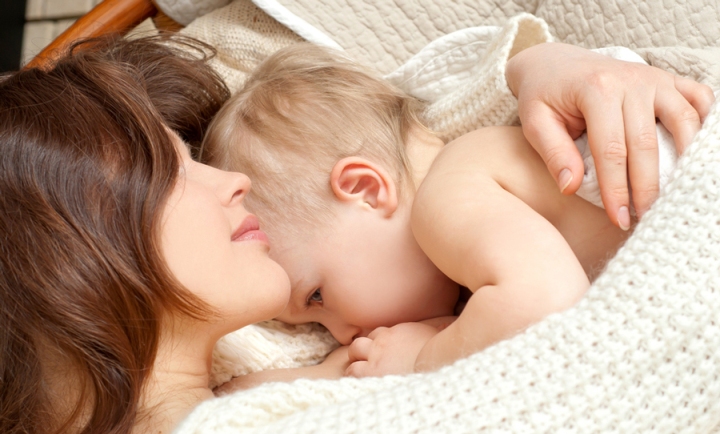
There are many milk mixtures for premature children. But, before experimenting, you must first consult with doctors in the hospital, after with a pediatrician. Often children's doctors advise milk mixtures that can be found in a dairy kitchen at a district children's clinic, for example:
- "Robolakt" - specifically for premature children
- "Baby"
- "Baby"
- "Detolax"
- "Linolac"
In order for a premature child to get more necessary vitamins, experts advise, after the first month, to start giving fruit and vegetable juices in small portions. You need to start with half a teaspoon, if there is no allergy to the product, it is worthwhile to increase the portion by half a patch daily.
Children with artificial nutrition are starting the first complementary foods already from four months:
- Many mothers mistakenly think that you need to start with cereals or fruit puree - this is a great error.
- Pediatricians are strongly advised to feed vegetable puree (cauliflower, broccoli, zucchini). These products contain the least allergens, it is with them that it is correct to start the first acquaintance with adult food.
- After vegetable mashed potatoes, egg yolk is introduced, boiled screwed and wiped through a sieve with a small portion of milk. It is also worth starting with a quarter of the yolk, gradually increasing the portion.
- From 5.5-6 months, the baby can begin to try porridge-buckwheat, rice, corn, oatmeal. These cereals have more beneficial vitamins and trace elements that are so necessary for a non -stronger body.
After 6-7 months, a premature baby on artificial feeding begins to give soups in the form of mashed potatoes. After eight months, the baby begins to receive minced meat in the amount of two teaspoons with any vegetable mashed potatoes.
Advice: At ten months, the minced meat can be stopped wiping and it is possible to give the child in the form of small meatballs.
Next, the baby receives various cookies and crackers for chewing.
General regime of the day, recommendations and development of premature children
It is no secret that premature children are more weak than the babies born on time. When discharge, doctors advise mothers not to waste time and begin to engage in various gymnastics and physical education with a newborn. This will help to develop the physical abilities of the baby.
It is worth knowing: In the first year of life, the newborn will have to face a mass of vaccination. If the child was born weighing below 1500 kilograms, vaccinations are transferred to a later date.
For good development, a small person, like an adult, needs constant physical preparation and massage procedures. What exactly needs to be done by a young mother will tell the doctors in the clinic.
Remember: A premature child continues to grow and develop outside the womb of the mother, so all the recommendations of pediatricians should be performed impeccably.
In the first months of life, most children suffer from gas formation (colic). The easiest solution in this case will be before each feeding to lay out the baby for a couple of minutes on the stomach. This will help not only calm discomfort, but also strengthen the muscles of the arms, legs, abdomen and occipital part of the head.
At the beginning of the life path and up to one year of many children, several more diseases are in wait - anemia and rickets. Different drugs and good nutrition are prescribed from anemia. Doctors knowing about this potential threat often prescribe vitamins of certain groups, these tips should not be neglected. Read more about rickets further.
Racititis in a premature child: causes, signs, diagnosis, treatment

Immediately after the birth of a child, doctors recommend consuming as many products rich in vitamin as possible D.. However, not every parent refers to these instructions with complete seriousness and responsibility. Sometimes a lack of vitamin D. It can lead to serious and, unfortunately, sometimes irreversible changes in the child's body.
- Rickets - a disease caused by a lack of vitamin D.As a result of which there is a bone deformation, accompanied by a metabolic disorders.
- Usually occurs in full -term and premature children by age from 2 months to a year.
- The cause of rickets in a premature baby is also a lack of vitamin D..
- The child’s body is weakened and therefore cannot develop it fully.
Experts distinguish between two types of disease: vitamin-deficiency and vitamin-resistant. And if in the first case the deficiency of vitamin is presented D. In the body, then in the second one can no longer do with standard therapy.
In addition, the course of the disease is divided into three stages:
- Light - symptoms are weakly expressed, mainly through the nervous and bone system.
- Moderate severity-changes in the muscle, circulatory, nervous and bone systems of a pathological nature, minor violations of the respiratory system and the gastrointestinal tract.
- Severe - sharp and fleeting change in all of the above organs and systems.
Signs of rickets
- Rickets are usually accompanied by a decrease in immunity, as a result of which children often suffer from viral diseases.
- The lesion of the bone system is most strong, especially at the age when the child begins to walk.
- It is during this period of life that the spine is damaged: lordosis (an inclination forward), kyphosis (abduction back) and scoliosis (inclination to the side)
- The chest and bones of the pelvis are also deformed, forming the so -called narrow pelvis, which is especially dangerous for girls.
The first signs of rickets make themselves felt in 2 months age and accompanied:
- Sleep violation
- Anxiety
- Sweating of the head
- Irritability
- Bolding the back of the head
After a time when the baby grows a little, these signs join:
- An increase in frontal and parietal tubercles.
- The appearance of "rickets" is a thickening of the cartilage and bone part of the ribs.
- The appearance of a "rickets".
- An increase in the volume of the abdomen is a “frog” stomach.
- The curvature of the bones of the legs is in the form of the letter X or O.
- Deformation of the bones of the pelvis.
- Violation of the cycle of teething.
In the absence of the necessary treatment, these features can develop in 3 year old the age of the child.
Diagnosis of rickets
- It is performed by passing tests: the amount of calcium in the blood, a change in the activity of alkaline phosphate. Usually in children of patients with rickets, low citric acid (hypocytrem).
- An X -ray picture of long bones, for example, legs, is assigned. Their x-circular or o-arrangement is noticeable.
- The orthopedic traumatologist prescribes urine analysis to determine the calculation of the creatinine coefficient, the study of the degree of provision of the body with vitamin D and the number of biochemical markers of bone metabolism.
Other blood and urine studies, instrumental examinations and examinations among specialists are also carried out. What kind of diagnostic method to choose, your attending pediatrician decides.
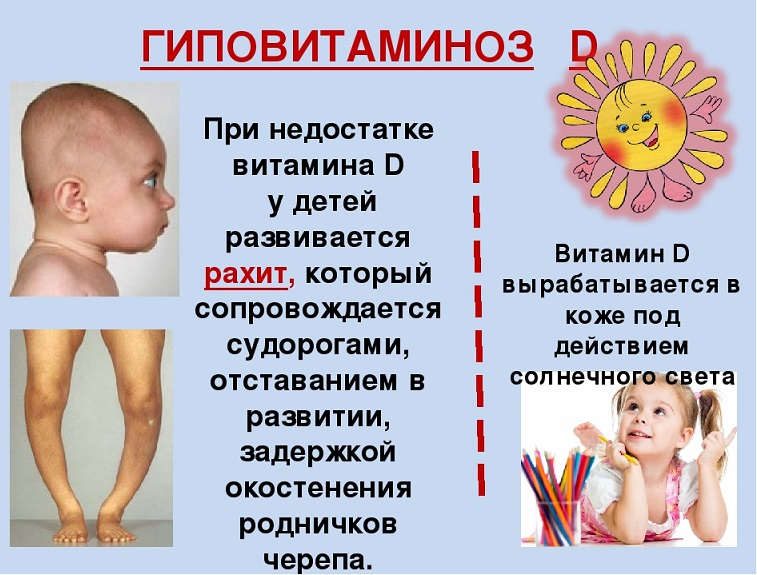
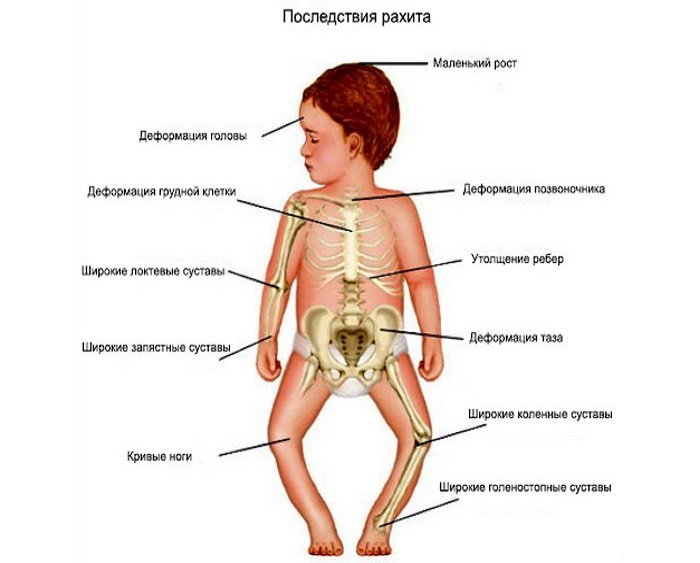
Treatment of rickets
Mostly children are prescribed by vitamin D2 and D3. Special doses of these drugs are prescribed by a doctor, so it is extremely not recommended to treat the child on their own. Also, a special diet aimed at improving metabolism and replenishment of vitamins missing in the body will not be superfluous.
Prevention of rickets
Prevention of rickets is prescribed during pregnancy: a woman should walk for two to three hours every day, use special milk drinks that contain a balanced vitamin complex.
After the birth of a child, especially if he is prematurely, regular walks are also needed and the most frequent use of sunbathing, but in warm calm weather. It is worth considering that it is enough to spend about an hour a day in the sun to obtain the required amount of vitamin D..
It's important to know: It is necessary to walk even in cloudy weather, because vitamin is not contained in direct sunlight, but in a natural ultraviolet that penetrates regardless of the weather.
In the winter, it is necessary to give vitamin to a premature child D.The use of vitamin -containing products will also not hurt.
Remember: The consequence of rickets will remain with the child for life, and it is easier to prevent the disease than to suffer from the consequences.
If you impeccably follow all the recommendations from doctors, monitor the growth and development of their child, premature babies begin to grow at an increased pace, trying to catch up. Today, medicine is developing more and more. Even very premature children are developing well and catch up with other babies by 2-3 years. Frequent cases when newborns, which had been born in a body of more than one kilogram, were caught up in the development of other children for one year.
Video: Honest answers to questions about premature children

